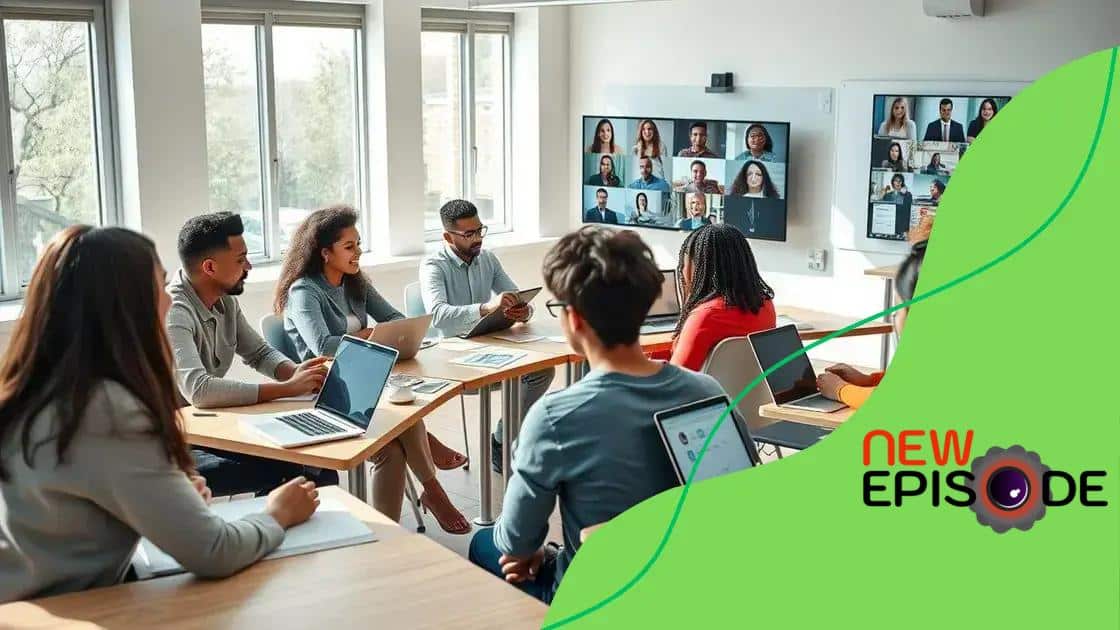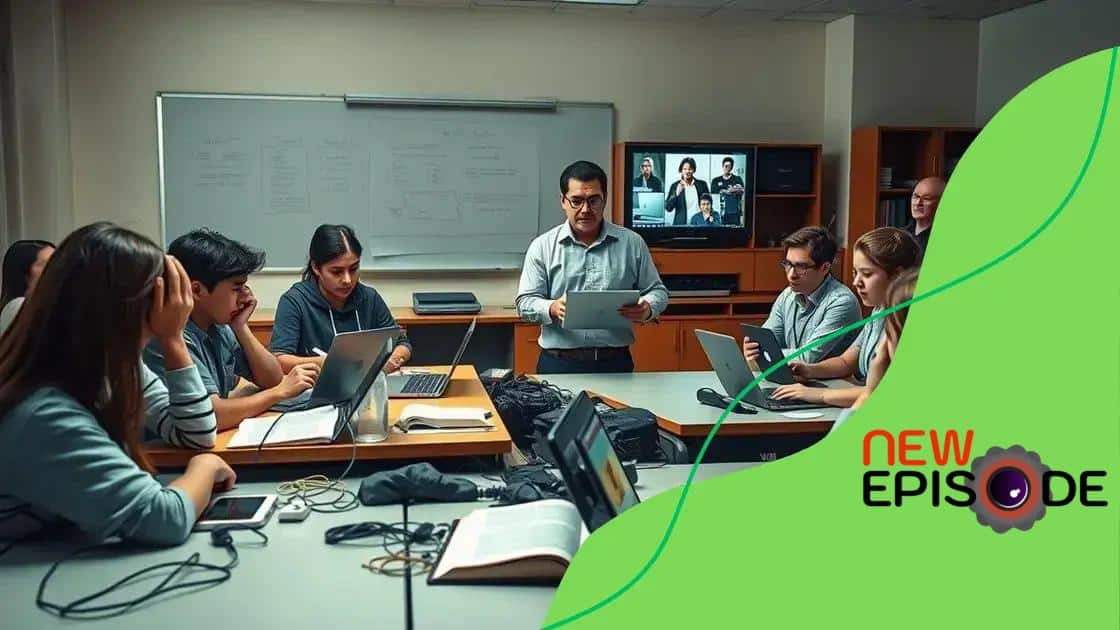The future of hybrid learning environments in universities

The future of hybrid learning environments in universities focuses on personalized education through technology, enhanced engagement via immersive tools, and fostering community among students while addressing challenges like technology access and maintaining communication.
The future of hybrid learning environments in universities is here, and it’s changing how students engage with their education. Have you ever wondered how blending online and in-person classes affects your learning experience? Let’s dive into this evolving landscape.
Understanding hybrid learning environments
In today’s educational landscape, understanding hybrid learning environments is essential. These setups combine traditional face-to-face classes with digital learning, creating flexible opportunities for students.
Hybrid learning allows for diverse learning styles and schedules. By using both in-person and online methods, educators can tailor experiences to better meet the needs of each student.
The key components of hybrid learning
Several elements contribute to effective hybrid learning environments. Here are a few of the most important:
- Accessible technology: Reliable internet access and user-friendly platforms are crucial.
- Engaging content: Interactive materials that stimulate interest help keep learners motivated.
- Supportive community: Building connections, even virtually, can enhance student success.
- Flexible assessment: Different evaluation methods can accommodate various learning preferences.
Moreover, hybrid learning environments foster collaboration among students. By utilizing discussion forums and group projects, students can interact and build relationships, regardless of their physical location. This aspect is particularly valuable in a globalized world where interaction with diverse cultures is essential.
Teachers also play a vital role in these environments. They must adapt their teaching strategies to include both remote and onsite learners. This might involve recording lectures or creating supplemental online materials to ensure everyone has access to the same information.
Benefits of understanding hybrid environments
Understanding hybrid learning not only benefits students but also educators. Some advantages include:
- Increased engagement through varied content delivery.
- Better time management as students can learn at their own pace.
- Preparation for a tech-driven future where digital skills are paramount.
In essence, comprehending hybrid learning environments equips students and educators alike to thrive in a rapidly evolving educational landscape.
Benefits of hybrid learning for students
One of the significant aspects of hybrid learning for students is its flexibility. This approach allows learners to choose how they want to engage with the material, whether in-person or online. This option can be especially beneficial for those balancing work or personal commitments.
Students can also enjoy a personalized learning experience. With various resources available, they can progress at their own pace, revisiting difficult concepts as needed. This flexibility helps to accommodate different learning styles.
Key benefits of hybrid learning
Some main advantages include:
- Access to diverse resources: Students can utilize educational platforms, videos, and articles to enhance their understanding.
- Fostering independence: Learners develop self-discipline and time management skills by navigating their own study schedules.
- Enhanced interaction: Online forums and discussions encourage collaboration with peers and instructors, leading to richer learning experiences.
- Preparing for the future: Students gain valuable experience using technology, an essential skill in today’s job market.
Moreover, the hybrid format allows students to connect with classmates from various backgrounds, broadening their perspectives. This diverse interaction fosters empathy and cultural awareness. When students engage in both in-person and online discussions, they often discover fresh ideas and solutions.
Technology plays a crucial role in enhancing the learning experience. Learning management systems, virtual classrooms, and interactive tools make it easier for students to engage comprehensively. With these resources, students can access materials anytime, anywhere, providing the opportunity for continuous learning.
Improved academic performance
Research shows that students in hybrid environments often experience higher academic performance. The blend of instruction methods caters to various learning styles, helping to ensure no one is left behind. This adaptability makes learning more effective and enjoyable.
In essence, the advantages of hybrid learning for students are clear. This approach not only supports individualized learning but also prepares students for the evolving educational and professional landscape.
Challenges faced in hybrid educational models

Challenges faced in hybrid educational models are important to understand for both educators and students. While this approach offers several advantages, it also presents unique obstacles that must be addressed.
One major challenge is ensuring that all students have equal access to the necessary technology. Some learners may not have reliable internet connections or devices, which can hinder their ability to participate fully. This digital divide can create disparities in learning outcomes, making it vital for institutions to find ways to support these students.
Technological issues
Technical difficulties can disrupt the flow of lessons and frustrate both students and teachers. Common problems include:
- Internet connectivity: Unstable connections can interrupt live sessions and hinder access to online materials.
- Platform compatibility: Not all devices work seamlessly with every educational tool, leading to confusion.
- Technical support: Students may require assistance navigating technologies, which can distract from learning.
Another challenge is maintaining student engagement. In traditional classrooms, teachers can use body language and proximity to connect with students. In a hybrid environment, this connection can be harder to achieve. Teachers need to be creative and find new ways to engage all students, whether they are learning online or in-person.
Communication barriers
Communication is also an essential component of successful learning. In a hybrid model, students and teachers must navigate different communication styles. Some may feel more comfortable speaking up in-person than they do in virtual discussions. This variance can lead to misunderstandings or a lack of participation from students who feel less confident in online settings.
Moreover, the need for clear expectations and guidelines becomes crucial in hybrid environments. When students are unsure of what is expected, they may struggle to stay on track. Regular check-ins and clear communication from educators can help alleviate this challenge.
Despite these challenges, it’s important to remember that with the right strategies and support, many of these obstacles can be overcome. Adapting to a hybrid model takes time and flexibility from both educators and students.
Technological tools supporting hybrid learning
Technological tools play a vital role in supporting hybrid learning. These resources enhance the educational experience by making it more interactive and flexible. With the right technology, both teachers and students can engage actively, regardless of their physical location.
Learning management systems (LMS) are among the most essential tools. They help organize online content and track student progress. With platforms like Canvas or Moodle, educators can create assignments and provide feedback easily.
Key technological tools for hybrid learning
Several tools are particularly helpful in a hybrid model:
- Video conferencing software: Programs like Zoom or Microsoft Teams allow real-time communication, making it easier for teachers and students to connect.
- Interactive whiteboards: These tools help facilitate group discussions and idea sharing, whether students are remote or in the classroom.
- Online collaboration tools: Applications like Google Workspace enable students to work together on projects seamlessly.
- Assessment tools: Services like Kahoot and Quizlet help educators create engaging quizzes that keep students motivated while learning.
These tools help create a more inclusive learning environment. By using a combination of in-person and online resources, teachers can cater to different learning styles. This adaptability ensures that students are more engaged and invested in their learning.
The importance of training
While technology can enhance hybrid learning, it is crucial for educators to receive proper training. Understanding how to use and implement these tools effectively makes a significant difference in student outcomes. Ongoing professional development can help teachers stay updated with the latest technological trends.
As technology continues to evolve, so will the resources available for hybrid learning. Staying informed and adaptable will ensure that educators can provide the best possible learning experience for their students.
Future trends in university hybrid learning
The future trends in university hybrid learning are shaping the way students and educators interact with education. As technology advances, educational institutions are adapting to meet the needs of a changing world.
One significant trend is the increasing use of artificial intelligence in the learning process. AI can provide personalized learning experiences by analyzing student performance and suggesting tailored resources. This level of customization helps address individual learning styles and paces, making education more effective.
Integration of immersive technology
Another exciting development is the integration of immersive technologies, such as virtual reality (VR) and augmented reality (AR). These tools offer students unique opportunities to engage deeply with the material. For example, medical students can participate in realistic simulations to practice procedures without the risk of real-world consequences.
- Enhanced engagement: Immersive experiences capture students’ attention and make learning enjoyable.
- Real-world application: Students can visualize concepts in tangible ways, improving retention and understanding.
- Accessibility: VR and AR can create opportunities for remote students to experience hands-on learning.
Alongside these technologies, there will be a greater emphasis on data-driven decision-making. Universities are collecting more data regarding student performance, attendance, and engagement. By analyzing this data, colleges can make informed decisions about curriculum design, resource allocation, and student support services.
Collaboration and community building
Future trends will also revolve around fostering collaboration and community among students. Hybrid learning environments promote teamwork through online discussion forums, group projects, and peer feedback. Universities are creating platforms to facilitate these connections, making it easier for students to engage with their peers and instructors.
Finally, flexibility will remain a key component of hybrid learning. As students continue to juggle multiple responsibilities, universities will offer more options for asynchronous learning alongside synchronous classes. This flexibility allows students to tailor their educational journey, balancing their academic and personal lives.
FAQ – Frequently Asked Questions about Hybrid Learning in Universities
What is hybrid learning?
Hybrid learning is an educational approach that combines traditional face-to-face classroom instruction with online learning activities.
What are the main benefits of hybrid learning?
Hybrid learning offers flexibility, personalized learning experiences, and access to diverse resources, enhancing student engagement.
What challenges do universities face with hybrid learning?
Challenges include ensuring technology access for all students, maintaining engagement, and managing communication between in-person and online students.
How can technology improve hybrid learning environments?
Technology enhances hybrid learning by providing tools for collaboration, interactive learning experiences, and data-driven insights to support student success.






